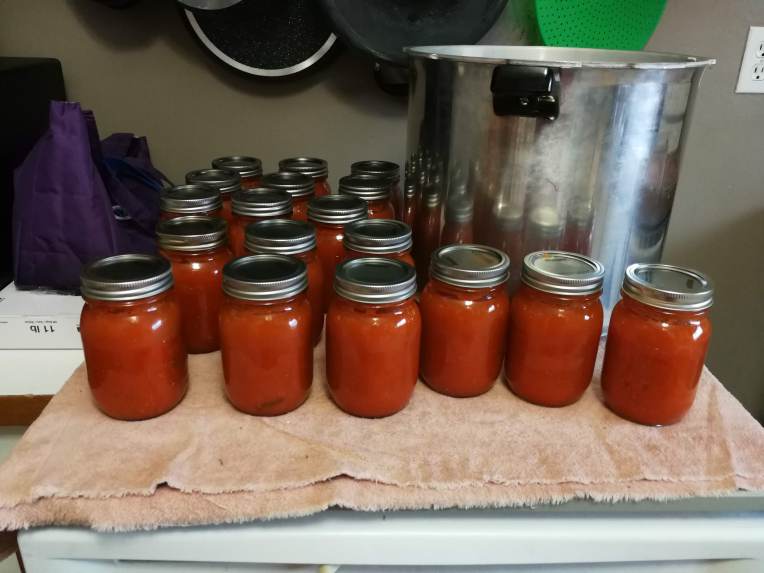Tomatoes are the perfect canning ingredient. They make excellent additions to a wide variety of recipes and they can beautifully. But they’re also a ton of work and require some specialized knowledge to get right, so here’s what I’ve learned so far.
Ingredients, from the Presto Pressure Canner Manual, FDA-tested:
- 30 pounds ripe tomatoes
- 1 cup chopped onions
- 5 cloves minced garlic
- 1 cup chopped celery OR green pepper
- 1 pound fresh mushrooms, sliced (optional)
- 1/4 cup vegetable or olive oil
- 1/4 cup brown sugar (I omitted this)
- 4 tablespoons minced parsley (I forgot to buy this)
- 2 tablespoons oregano (I used fresh instead of dried and more than this)
- 4 1/2 teaspoons salt
- 2 teaspoons black pepper
- My addition: half a cup chopped fresh basil
The recipe says not to increase the proportion of onions, peppers, or mushrooms. I take that to mean you can play with the spices and herbs a little bit with impunity.
Selecting Tomatoes
The first tomatoes to come on a good sale in most stores around here are big field tomatoes. Don’t use them for canning. They’re mostly water and they’re picked underripe, so they’ll be super-acidic and you’ll have to cook them forever to get a good consistency. The Italian grandmother in the grocery store talked me out of those. The key, according to that lovely granny, was that they should smell sweet and flavourful.
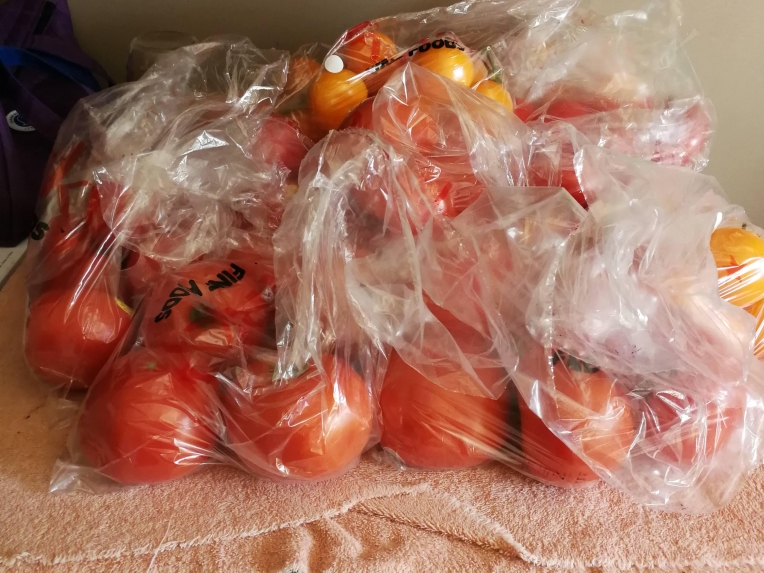
If you are too impatient to wait for the big boxes of Roma tomatoes that the Italian grannies use, the next best thing is the cluster tomatoes still on the vine. They have to be ripe enough to fall off the vine with almost no pressure. That’s what I bought, and the ones that were on the best sale were orange.
I used a mix of types for this recipe: about half were orange and the rest were cluster red tomatoes and a few Romas I found.
If you wait about a week longer than I did, you can buy a case of Roma tomatoes for about a third of what I paid. I did that too, and canned them for other recipes. But that’s a different story.
Prepping Tomatoes
The first job, and the most labour-intensive one, is to skin the tomatoes. You do this by starting a small pot of boiling water, letting a few tomatoes boil for a minute or two, transferring them to ice water, and then to a cutting board. Wait until they’re cool enough to handle and then the skins should come off pretty easily. Sometimes the skins will crack while they’re in the boiling water, but sometimes they won’t and you can still peel them.
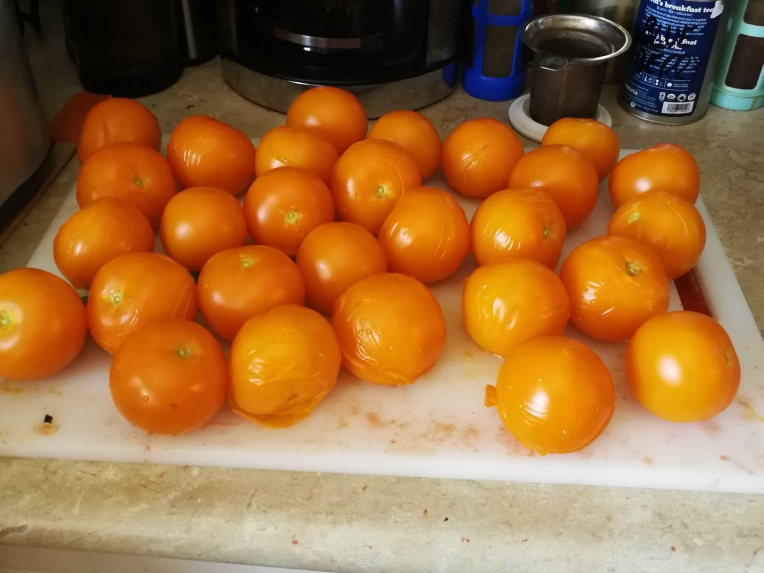
First Cooking
Yes, the cooking is done in two stages. The first stage is to get the tomatoes to release their juices. This takes about half an hour for a full pot (I had a very full pot.) I cut out the cores, chopped them in half, and put them on to cook. After a while, when there was more juice than there had been, I took a potato masher to them. When they were pretty thoroughly crushed and offering no further resistance, I transferred them to my food processor to blend into a smooth purée.
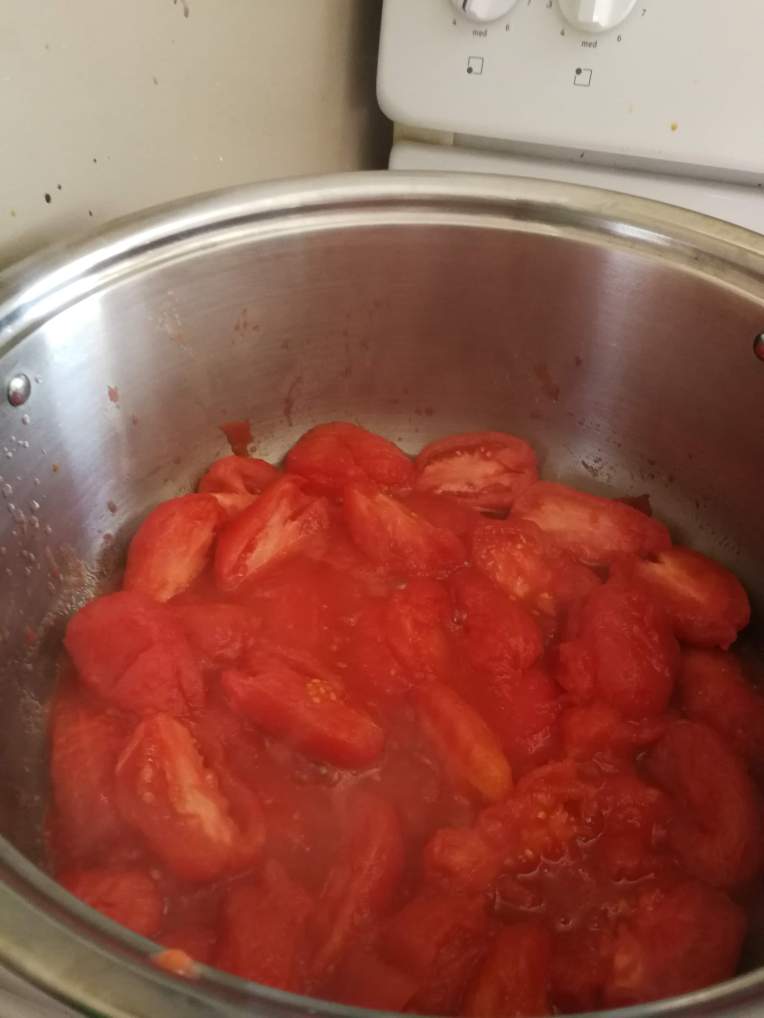
You’re going to have to process the first cooking of the tomatoes in a few batches, probably, and then find a way to set them aside until you’ve got them all ready to go in the same pot. I found I had too much to go in the same pot until halfway through the second cooking phase.
Is it sauce yet?
Now that you’ve got all your tomatoes puréed and hopefully down to only one or two pots (I had three) you get to put it all on the heat for the second cooking. This is the stage where you simmer it until the bulk of the water evaporates. You’re going to diminish the volume of this sauce by a third to a half, and it takes a couple of hours, depending on the juiciness of your tomatoes.
After you get the tomatoes started on their second cooking, grab a frying pan and your olive oil, onion, garlic, green pepper/celery, and mushrooms. Cook it all in the frying pan until it’s soft, then add it to your biggest pot (hopefully your only pot) of cooking tomatoes. This is also where you add your green herbs or dried ones if that’s what you’re using. (Seriously, splurge on the fresh stuff. I’ll show you what to do with the leftover fresh herbs, but even if they go bad in the fridge, it’s worth using them in this recipe.)
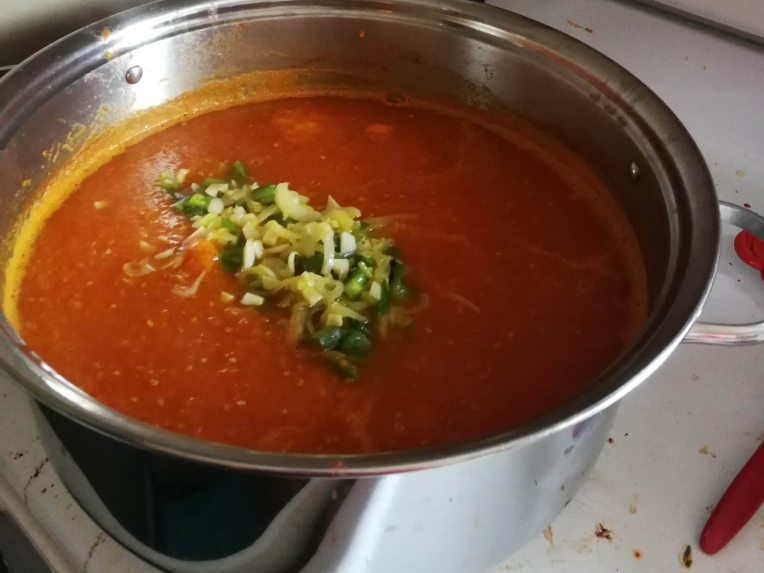
Now you sit and watch your sauce simmer down until there’s a whole lot less of it. Stir it pretty often. If you’ve got things in several pots, you want to gradually reduce down to just one pot. During this time, prepare your jars. The recipe says it made nine pints; I got double that, so I guess I didn’t cook it down as much as they were expecting.
If you want to water-bath can this recipe, it’s safe to do so IF you add extra acid, probably in the form of lemon juice or vinegar. We have acid reflux dogging our recipe choices in this household so I didn’t want to increase the acidity, and I can get more jars in my pressure canner than in my water-bath canner anyway.
Go through the jarring and pressure-canning process, 20 minutes for 500mL jars and 25 for 1L jars, at 11 pounds of pressure, then enjoy your sauce for as long as it takes you to eat it all.
